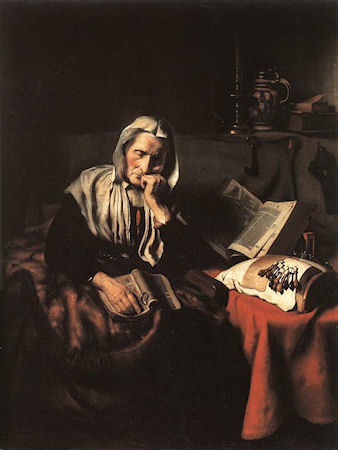

I found this quote in a book "History of Lace" by Mrs. Bury Palliser, published originally in 1875. I don't know how accurate it is, but she seems to be careful with her references, and quotes dates, and so on. She says "In 1651, Jacob v. Eyck, a Flemish poet, sang the praises of lace-making in Latin verse:
"Of many arts one surpasses all; the threads woven by the strange power of the hand, threads which the dropping spider would in vain attempt to imitate, and which Pallas would confess she had never known; For the maiden, seated at her work, plies her fingers rapidly, and flashes the smooth balls and thousand threads into the circle, Often she fastens with her hand the innumerable needles, to bring out the various figures of the pattern; often again, she unfastens them; and from this, her amusement makes as much profit as a man earns by the sweat of his brow; and no maiden ever complains at even of the length of the day. The issue is a fine web, open to the air with many an aperture, which feeds the pride of the whole globe; which surrounds with its fine border cloaks and tuckers, and shows grandly round the throats and hands of kings; and, what is more surprising, this web is of the lightness of a feather, which in its price is too heavy for our purses. Go, ye men, inflamed with desire of the Golden Fleece, endure so many dangers by land, so many at sea, whilst the woman, remaining in her Brabantine home, prepares Phrygian fleeces by peaceful assiduity."
A little glossing: Pallas Athene was the Greek goddess of domestic crafts. Jason and the Argonauts were Greek heros who sailed to find the Golden or Phrygian Fleece. Brabant was a duchy in 1651, including the city of Brussels, which was famous for bobbin lace. When he says needles, he means pins, and the 'balls' are the bobbins, which had balls at the ends.
The description of making lace is wonderful. The 'thousand threads' are exaggerated, but with the 'innumerable needles' it shows that we are talking about a serious width of lace. The 'circle' may be the pillow (although see below), although the later 'globe' is the world. It describes the movement of the bobbins, and putting in and taking out pins. It also describes how it's used, to trim cloaks and tuckers, and provide collars and cuffs for kings. I like the comparison of the lightness of the lace and the 'heaviness' of the price!

This Dutch painting by Nicolaes Maes is called Old Woman Dozing. It was painted in 1656. The pillow is put to one side while the lacemaker has a little nap. The bobbins have a ball at the end, and are unspangled. This type of bobbin is still used in mainland Europe. You can just see the 'needles' (pins). The pillow is curved, although you would hardly call it a circle in the sense of a cookie pillow. Perhaps the 'circle' refers to the fact that the bobbins take up more room than the lace on the pillow, and so tend to cluster in the shape of a circle. Or perhaps the lacemaker is making a circle of lace, such as a lace collar.

These are two famous paintings - by Caspar Netscher, painted in 1662, on the left, and by Vermeer, painted around 1669-1671. They are both Flemish (Dutch). The lacemakers are both putting in a pin. 'Often she fastens with her hand the innumerable needles, to bring out the various figures of the pattern; often again, she unfastens them;...'
© Jo Edkins 2017 - return to lace index